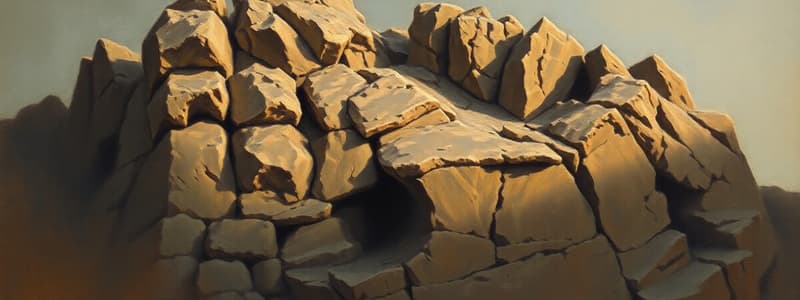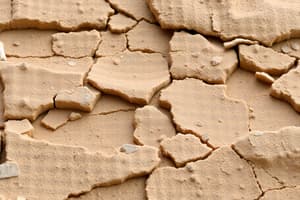Podcast
Questions and Answers
What are the two major groups of sedimentary rocks?
What are the two major groups of sedimentary rocks?
- Chemical and clastic (correct)
- Metamorphic and igneous
- Organic and non-organic
- Intrusive and extrusive
Which of the following best describes the composition of clastic sedimentary rocks?
Which of the following best describes the composition of clastic sedimentary rocks?
- Eroded pieces of rock and mineral fragments (correct)
- Homogeneous solid crystals
- Only chemical precipitates
- Organic materials and soil
What type of physical alteration does weathering involve?
What type of physical alteration does weathering involve?
- Formation of new minerals only
- Chemical changes in mineral composition
- Physical breakage into smaller fragments (correct)
- Complete rock dissolution
Which type of pore allows fluid to flow through subsurface conditions?
Which type of pore allows fluid to flow through subsurface conditions?
What is the primary role of porosity in reservoir rocks?
What is the primary role of porosity in reservoir rocks?
What process does the formation of clastic sedimentary rocks primarily involve?
What process does the formation of clastic sedimentary rocks primarily involve?
Which of the following transport media is NOT associated with sediment transport?
Which of the following transport media is NOT associated with sediment transport?
What characterizes chemical weathering?
What characterizes chemical weathering?
Flashcards are hidden until you start studying
Study Notes
Sedimentary Rock
- Two major types of sedimentary rocks:
- Chemical: Formed by mineral precipitates from chemical or biochemical processes - Clastic (Detrital): Formed from eroded rock fragments (mineral or rock)
- Clastic rocks dominate Earth’s crust
Characteristics of Clastic Rocks
- Composed primarily of silicate fragments called "clasts"
- Examples: quartz, granite, basalt
- Formation process: weathering & erosion, transport, deposition, and lithification
Clastic Rock Components
- Clasts (c)
- Matrix or groundmass (m)
Porosity
- Important property for hydrocarbon reservoirs (oil and natural gas)
- Pores can be filled with fluids
- Pore types:
- Macropores: larger than 5 microns
- Micropores: smaller than 5 microns
Pore Classification
- Catenary pores: allow fluid flow in subsurface conditions
- Cul-du-sac pores: can be filled with fluids but do not allow flow
- Closed pores: generally empty, do not allow fluid flow
Clastic Rock Formation Cycle
- Weathering & erosion > Transport > Deposition > Lithification
Weathering and Erosion
- Physical alteration of rocks exposed to atmospheric influences
- Physical weathering: breaks bedrock into smaller fragments, mineral composition remains unchanged
- Chemical weathering: reactions between water, dissolved ions, and solid rock that produce new materials
Sediment Transport
- Various transport mediums:
- Landslides and rockfalls - Eolian transport (winds and air currents)
- Glacier transport (glaciers)
- Stream and river transport (continental water)
Studying That Suits You
Use AI to generate personalized quizzes and flashcards to suit your learning preferences.




